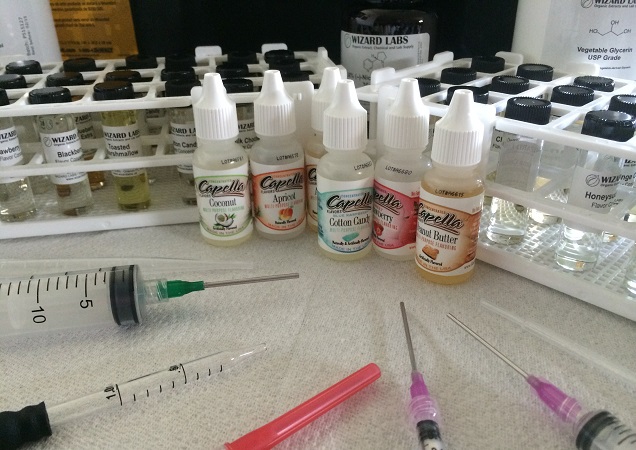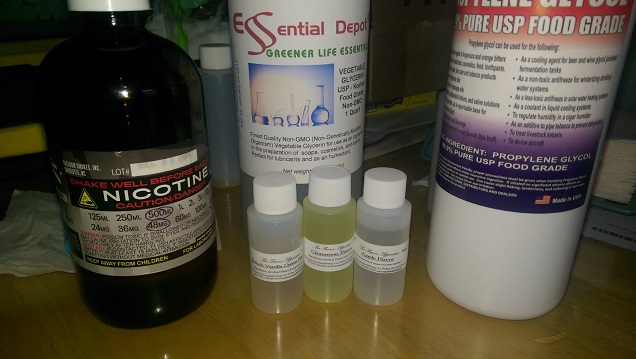
A new study takes aim at flavoring mixtures used for DIY e-liquid mixing, finding that some concentrated flavors contain nicotine. As you may expect, Stanton Glantz was quick to jump on the findings, claiming that the authors were “too polite” to point out that, “It is in the interest of e-cigarette sellers to spike their products with the addictive drug nicotine to ensure customer loyalty,” and even goes on to say that “policymakers should not believe claims that some e-cigs do not contain nicotine.”
The extreme (and completely unsubstantiated) statements of Glantz aside, it is genuinely a cause for some concern if concentrated flavors contain nicotine and don’t disclose it, but only an uninformative extract of the study is available if you don’t buy the full study or have access. Thankfully, we do have access, so here’s what they really found.
The Study – Do Concentrated E-Liquid Flavorings Contain Nicotine?
The researchers obtained 30 different e-liquid flavorings from a vendor called Tasty Puff (warning: the site plays horrendous music) and analyzed them for nicotine using high performance liquid chromatography and gas chromatography-mass spectrometry. The focus on one vendor is an obviously limitation right off the bat – even if all of the tested flavorings contained nicotine, it wouldn’t be applicable to the whole industry. Of course, they could have easily sampled options from numerous flavoring companies to add some weight to the findings, but they didn’t.
Of the 30 flavors, there were four bottles with detectable quantities of nicotine, meaning that over 86 percent of the tested flavorings contained no nicotine whatsoever, as expected. This point isn’t stressed in the paper, though, and two of the flavorings found to contain nicotine were actually versions of the same flavor (Sinful Cinnamon). These two cinnamon flavorings had nicotine, but at levels below the limit of quantification, meaning that there was less than 0.01 mg/ml of nicotine present.

The remaining two flavorings, Nilly Vanilla and Joosy Fruit, contained 14.2 and 95.4 mg/ml of nicotine, respectively. Diluted to 10 percent of an e-liquid – assuming you wanted to mix one that was nicotine-free – this would lead to concentrations of about 1.4 and 9.5 mg/ml, respectively. The authors point out that the 5 ml bottles the flavors were sold in would contain 71 and 477 mg of nicotine, and that this would make them fatal to children if swallowed, and (for the latter) possibly to adults.
They cite Bernd Mayer’s revised estimate of nicotine’s toxic dose (500 to 1000 mg for adults), but bizarrely claim 10 mg is a toxic dose for children, citing an InChem page that’s inaccessible at time of writing. However, Mayer provides a lower limit for the toxic dose per kg of 6.5 mg, meaning that the authors’ statement would only be true for a child that weighed 1.5 kg or about 3.3 pounds, less than half the average weight of a newborn baby.
Drinking the whole bottle of the flavor concentrate containing the lower amount would be potentially fatal to an infant weighing 11 kg or about 24 pounds. This means this bottle would likely be fatal to children aged under 2 years old if he or she drank it all. However, the Joosy Fruit bottle undeniably contains potentially dangerous amounts of nicotine, and their statements are accurate in this case.
The authors rightfully point out that the products are presented as nicotine free (with the explicit statement, “It does not contain any nicotine” on the site), and this could be problematic for vapers looking to mix an e-liquid that’s nicotine free. They add – and Glantz gleefully repeats – that this could lead to “unwanted addiction, poisoning, or even death,” which is obviously something of an overstatement.
There is evidence from nicotine replacement therapy trials that nicotine, outside of tobacco smoke, doesn’t create addiction in non-smokers (more on this in an upcoming post), and poisoning and death would only result from drinking the whole bottle of flavoring, which would be unusual, to say the least. However, leaving an apparently nicotine-free flavoring within the reach of a child wouldn’t be too negligent an act, so the authors aren’t pushing the implications of the finding too far.
What Does This Mean for DIY Mixers?

The findings clearly don’t reflect well on Tasty Puff's quality control, and I’d advise avoiding their flavorings (and products altogether) as a result, unless they submit their flavorings and e-liquids for independent testing in future to demonstrate their reliability. However, the actions of Tasty Puff don’t really mean all that much for other flavoring companies. The key question would be why? Why would a flavoring company purposefully include nicotine when it’s more expensive than flavorings alone? (Although admittedly not by much)
I have no idea why Tasty Puff did it, but unless other companies want to purposefully reduce their earnings per bottle sold and expose their customers to nicotine for no real reason, it seems the results are unlikely to hold for other mixers. Stanton Glantz might like to pretend flavoring companies are out to secretly hook customers onto nicotine, but it’s a hard claim to swallow based on such scant evidence.
Conclusion – Unacceptable, But Hopefully Uncommon
It goes without saying that flavoring companies including nicotine in their products when they explicitly state that they don’t is completely unacceptable. However, it’s important to maintain perspective when thinking about this study: the vast majority of flavors were nicotine-free, as advertised, and only one contained nicotine in an amount that would even be noticeable when diluted. With this in mind, it would be nice to see further tests on flavorings offered by different companies, if only to confirm that this illogical action isn’t being taken by flavor concentrate companies overall. If you’re a DIY mixer on no-nicotine juices, it might be worth picking up a test kit to confirm that your mix is indeed nicotine free, but realistically I can’t see much reason to be worried.

